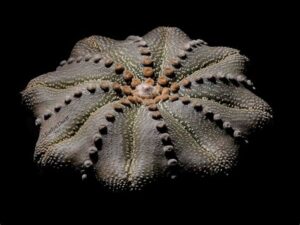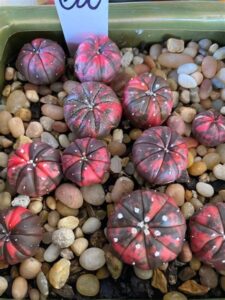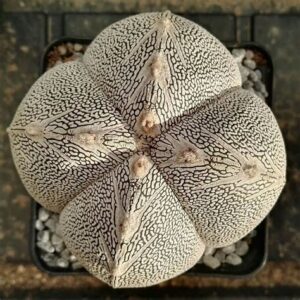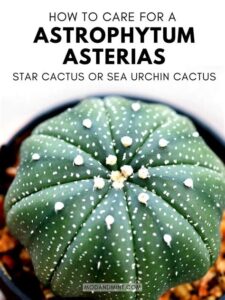Variegated Astrophytum, with their striking designs and sublime elegance, serve as nature’s miniature masterpieces. Just as a painter deftly blends colors upon a canvas, these unique cacti showcase their beauty through a mesmerizing patchwork of greens, whites, and sometimes even blushes of pink. Their rarity and stunning aesthetics have captured the hearts of gardening aficionados and collectors alike. Thus, understanding how to cultivate these wonders of the plant kingdom is both an art and a science. This article offers a comprehensive guide on nurturing variegated Astrophytum, ensuring they flourish gracefully as they adorn your collection.
The Allure of Variegation: Nature’s Kaleidoscope
What makes variegated Astrophytum truly captivating is their unpredictable patterns, reminiscent of a kaleidoscope. Nature does not follow a strict formula; rather, it plays whimsically with pigments, producing characteristics that charm and inspire cultivated admiration. Variegation is essentially a mutation, leading to areas of chlorophyll deficiency. In most cases, this phenomenon enhances the visual splendor of the cactus, prompting exploration into its myriad forms.
These enigmatic cacti primarily come in various species, including Astrophytum asterias and Astrophytum myriostigma. Each variant exhibits its distinct charm, with a panoply of patterns and forms. Just as every crack in a piece of antique pottery tells a story, the markings on a variegated Astrophytum embody the whimsy of evolution and the artful hand of chance.
Setting the Stage: Ideal Growing Conditions
For those wishing to delve into the world of variegated Astrophytum, it’s crucial to provide the right environment—similar to an artist selecting the perfect canvas. Begin by choosing a well-draining soil mix. Cacti require a substrate that prevents water retention, as pooling moisture can spell disaster for these succulents. A combination of coarse sand, perlite, and a gritty cactus mix typically offers an ideal blend, simulating their native arid habitats.
In terms of light, these cacti long for brightness but can be finicky. While sunlight is essential for their complex colorations to develop fully, too much direct exposure may scorch their delicate skin. A window with filtered light or a greenhouse setup with shade cloths can create a suitable haven. Nevertheless, ensure they receive at least four to six hours of indirect sunlight each day. Great care must be taken during the transition from low light to bright sunlight; acclimatization is key.
Temperature is another variable in their care equation. Variegated Astrophytum thrive in warm climates, with an optimal temperature range between 70°F and 85°F during the day. Nighttime temperatures can drop slightly, offering respite from the heat. During the winter months, they can tolerate cooler conditions but should never descend below 50°F. The rhythm of day and night, warmth and coolness, mirrors the natural flow of their native environments.
Watering Wisely: The Art of Hydration
In the realm of succulent care, water emerges as both a friend and a foe. Mastering the art of hydration can mean the difference between a vibrant Astrophytum and one that succumbs to rot. The golden rule is to avoid a schedule and instead adhere to the “soak and dry” method. Water only when the substrate is bone dry, allowing it to absorb moisture without suffocating the roots.
During the growing season, typically in spring and summer, these cacti will benefit from a more liberal watering approach, perhaps every few weeks. However, as autumn descends, cut back, allowing them to enter their dormant phase. The heartbeat of growth slows, and so should the influx of water. Many enthusiasts swear by the subtlety of the ‘finger test’; if the soil feels dry several inches down, it’s time to moisten. This simple act maintains balance, akin to an artist deciding when to bestow finishing touches on a masterpiece.
Nourishment: Feeding Your Astrophytum
Even the most beautiful of works needs sustenance, and variegated Astrophytum are no exception. A diluted cactus fertilizer during the growing season can be beneficial. Opt for liquid fertilizers with a low nitrogen concentration to avoid elongation and poor health, preserving the compact beauty that these cacti are known for. Typically, a fertilizer with a 5-10-10 ratio will suffice, administered every four to six weeks during active growth.
However, under-fertilization often holds a slight edge over over-fertilization. Cacti are adept at surviving in nutrient-poor conditions, making it more prudent to lean toward restraint. Just as a painter may choose minimalism to evoke emotion, minimal fertilization can yield stronger, sturdier plants.
Marvels of Mutation: Propagation Techniques
As your variegated Astrophytum flourishes, thoughts may turn to expansion. Propagation presents a unique opportunity for gardeners to share these stunning specimens. The most common method involves offset propagation—an art in itself. These offsets, or “pups,” form at the base of the parent plant, mimicking the way a tree spreads its branches, reaching for the sun.
Carefully detach these pups using a sterilized knife, allowing them to dry for a few hours before planting them in a fresh substrate adds an additional layer of beauty to the propagation process. Some may also opt for seed propagation. This journey requires patience, as it may take several months before the captivating variegation appears. In both cases, success lies in the balance of nurturing and respecting the plant’s natural inclinations, amplifying their inherent beauty.
Embracing the Bigger Picture: Common Issues and Solutions
No undertaking is without challenges, and caring for variegated Astrophytum is no exception. From pest infestations to disease, being equipped with knowledge is paramount. Watch for common culprits like mealybugs or aphids, which may attempt to invade your precious collection. An occasional misting of neem oil can act as a natural deterrent without harming the delicate structure of the plant.
Additionally, careful observation can prevent the dreaded overwatering—a frequent menace for many gardeners. As the condition of “root rot” sets in, it can often be too late for rescue. In these poignant cases, one should remove the affected roots and provide a fresh start, allowing the plant another chance at life. Adapting to these challenges speaks to the resilience of both the gardener and the plant, echoing the symbiotic relationship that makes propagation a rewarding pursuit.
The Grande Finale: Celebrating Your Collection
As variegated Astrophytum flourish in their newfound habitat, they become cherished members of your botanical collection. Their beauty beckons admiration, reminiscent of a sunset painting the sky, leaving viewers in awe. Just as an artist stands before their work, taking in the nuances of each brushstroke, take a moment to appreciate the intricate beauty of your cacti, each pattern telling stories of growth, care, and tenacity.
In conclusion, cultivating variegated Astrophytum is both a discipline and an art form, weaving threads of patience and passion into the tapestry of horticulture. With proper conditions, mindfulness in watering and feeding, and a keen eye for propagation, these charming cacti will thrive. Each unique specimen mirrors the artistry of nature and stands as a testament to the beauty and wonder found in the natural world.





Leave a Comment